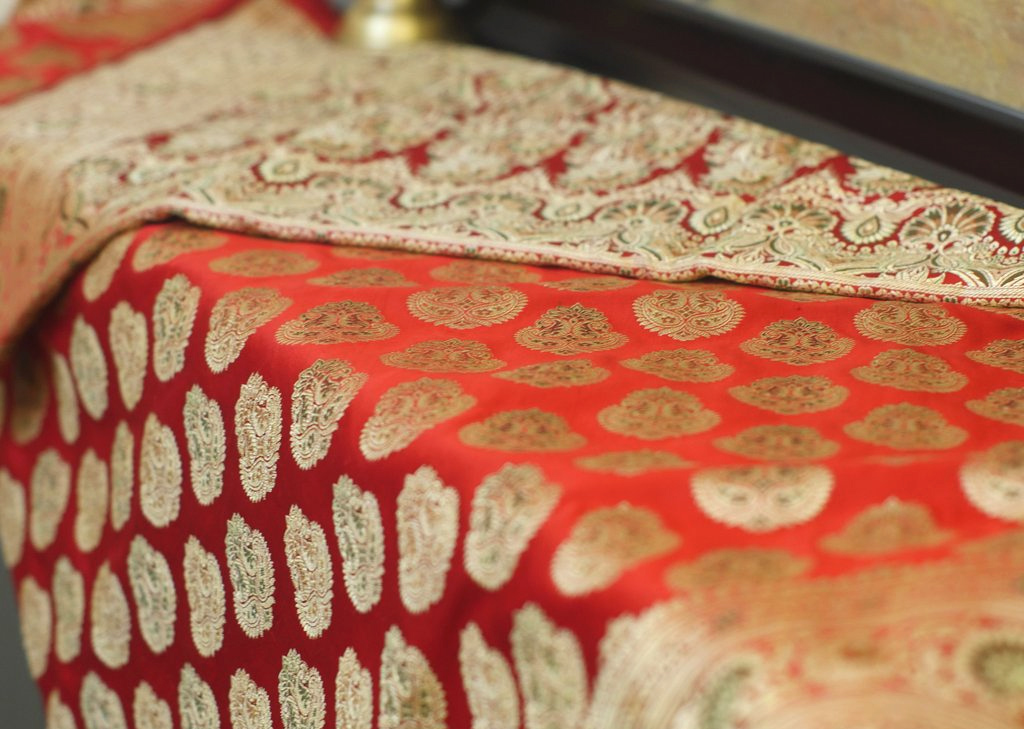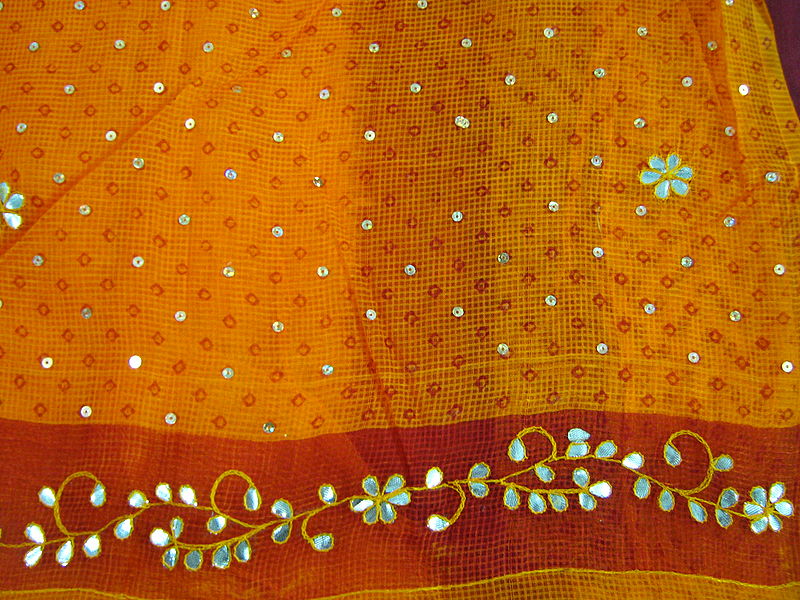The World of Indian Textiles
The World of Indian textiles and clothing (T&C) industry are one of the largest and oldest sectors in the country. It is an important sector of the economy in terms of output and investment and employs nearly 35 million people, making it the second-highest employer in the country behind agriculture. It accounts for around 4 percent of gross domestic product, 14 percent of industrial production, 9 percent of excise collection, 18 percent of employment in the industrial sector, and 16 percent of the country’s total export earnings. It has a direct link with the rural economy and the agricultural sector. The salient features of the Textiles of India are that it has a strong raw materials production base, a vast pool of skilled and unskilled labor, freely available cheap labor, export potential, and a low level of dependency upon imports.
This is a traditional, well-established industry that is enjoying considerable demand in both the domestic and the global markets. The remnants of Indian textiles have been found everywhere in Rome, China, and Egypt. India is a textile hub and has thousands of clusters that beautifully weave and offer are the most beautiful fabrics that mesmerize our eyes.
Also, Read Boycott Chinese Products
Here is our list of easily available from World of Indian Textiles:
Khadi: Fabric of Freedom
Introduced with the intention of boycotting foreign goods, khadi became a national movement under Gandhiji. All India Spinners Association was launched with the intention of propagation, production, and the selling of khadi in 1925. Techniques were improved upon, and employment to the scale of two lakh was created.

India Khadi is a handspun, hand-woven natural fiber cloth. Also known as khaddar during the British era, depict purely as India, or one can say it’s a swadeshi fabric. The fibers are spun into yarn on a spinning wheel called a charkha. It is a versatile fabric. Good in summers and warm for winters.
Kalamkari: Timeless Art from Andhra Pradesh
Kalamkari is a type of hand-painted or block-printed cotton textile, produced in Indian states of Andhra Pradesh and Telangana. It is more than just being a fabric used for clothing or home. It is more than textiles to an experience that culture has witnessed over centuries. This textile is supposed to be a multi-colored fabric in one of its rarest forms.
Kalamkari is known to be a healing fabric, as the colors, motifs, and the narration of magical forms create an aura that heals an individual physically and spiritually. Only natural dyes are used in Kalamkari, which is an ancient style of hand painting done on cotton or silk fabric with a tamarind pen.
Muga Silk
Muga silk is a beautiful kind of silk produced in Assam. It is mostly used in the production of sarees and ‘mekhla chaddars’ i.e. traditional saree is worn by Assamese brides that are white colored with a zari border. This material is highly durable and strong, though it looks delicate. This type of silk is produced from silkworms called Antheraea assama or muga silkworms. There are several thousands of families in Assam engaged in the production of Muga silk. The patterns traditionally used on Muga silk fabric are inspired by nature and the architecture in the area.
Banarsi Silk: Brides and Weddings?
The Banarasi saree is not only popular as part of the bridal wears in Bengal weddings but women from all religions and social status love this saree. This Banarasi saree is not only making waves in the Indian fashion industry but also in the international fashion world.

This ethnic wear has many intricate and complex designs woven into the six yards that make this saree stunning. Even with technology, Varanasi still uses hand-weaving techniques to weave intricate designs with gold and silver threads to make this Banarasi saree. These beautiful and elegant sarees have become very popular and every woman’s first choice when it comes to sarees. Their fashionable and exotic weavings by designers who use zari, motifs, and emeralds have become a favorite among women across the world. The world of Indian textile rates it in our Indian Brides Must-Haves.
Also, Read Wedding Jewelry: A Guide For Indian Brides
Pashmina: World’s Most Luxurious Fabric
Pashmina is made from the fineness of the cream-colored goat’s wool having intricate embroidery. Pashmina meaning soft gold in Kashmiri, some designs are hand block printed and those blocks sometimes date back to more than 100 years. It takes a week to get a single shawl of pashmina. Hand embroidery is done on the shawl which takes more time to make it an end product. The tedious work makes it one of the costliest fabric.
Heritage Ikat
There isn’t a technique in the modern world of Indian Textiles that is as ancient and relevant at the same time as Ikat. The origin of this craft is varied and doesn’t attach to one particular region in the world. The craft has thrived as a bystander of the trading practices and thus, has traveled the world along the famous trade routes. It was even used as currency in the Silk Road. The craft, although distinctly associated with Indonesia, no historian has been able to ascertain the exact location of origin for this craft. It has evolved from the world of Indian Textiles and flourished all over the world.
There are two different types of Ikat, Single, and Double. The Single Ikat method is where either only the Warp or the Weft is a tie and dyed with different colors so as to create patterns. The second and the advanced method is Double Ikat where both the warp and weft yarns are resist-dyed, making the weaving process complex and grand. The Double Ikat is produced only in three countries: India, Japan, and Indonesia.
Phulkari: An Old Embroidery Tradition
Phulkari is brought to the Indian Subcontinent by the migrant Jat people of Central Asia in ancient times. Techniques and patterns were not documented but transmitted by word of mouth. The tradition was associated with the Sikh heritage but was also shared with Hindus & Muslims. It has its origins in the famous love story of Heer & Ranjha (a love tale) by Waris Shah. It’s a present form and popularity goes back to the 15th century. The embroideries were a mere reflection of a woman’s life and every woman had her way of representing.
Kanchipuram Silk: Pride of Tamil Nadu
The Kanchipuram, or Kanchi, is woven in the temple city of Kanchipuram near Chennai. It is characterized by being woven with the murukku-pattu yarn — twisted yarn, to produce heavier weft and warp yams. The brilliant contrast borders with zari or silk thread are matched by the same colored pallu.
The borders are interlocked with the body in the Kovari technique, and the pallu is woven by laying the contrasting warp (of the pallu) next to each warp of the body by the laborious method of the pethni, perfected in Kanchipuram. Kanchipuram with lotus motifs Glorious colors of contrast characterizes the Kanchipuram.
Kota Doria: Royalty from Rajasthan
Kota Doria first originated in Mysore where the weavers who practiced this craft were known as ‘Masurias’. Subsequently, between the 17th and 18th centuries, the weavers were brought to Kota by Rao Kishore Singh who was a general in the Mughal Army during Shahjahan’s reign. The union between the two states brought about the invention of the ‘Kota-Masuria’ sarees, which were adorned for religious occasions since this type of material was considered auspicious. This type of saree became extremely popular and paved the way for the Kota Doria cloth, which went on to become one of the most fashionable fabrics in India.

The Rajasthani royalty favored this fabric since it portrayed effortless grace and style. The sarees were mostly white or beige in color. However, with recent changes and modifications being made to the fabric, endless amounts of color, and adornments of all kinds are included as well. Initially, the fabric was only made up of cotton, but later silk was weaved in as well, which made it more chic and refined.
Conclusion
These are some of the most famous and unique textiles from India. These textiles have been developed over time and their production has been passed on through generations. They reflect the culture of the people from the different regions in which they are produced.
Are you #vocalforlocale? Are you ready to buy from the world of Indian Textiles?





Pingback: 6 Organic Hair Care Products You Can Switch too - WarPaint Journal
Pingback: Indian Inventions that Contributed to the World - WarPaint Journal